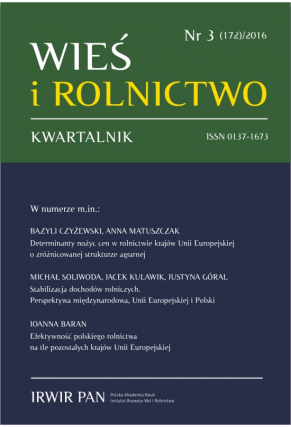The Importance of Improving Incentives and Employment Opportunities for Farm Households in Poland
DOI:
https://doi.org/10.53098/wir032017/01Keywords:
farm structure, rural development, part-time farming, local labour markets, agricultural policyAbstract
Poland is experiencing the first stages of a period where its active labour force will decline steadily over time. This has raised important concerns with how well labour markets in Poland function, especially those in rural areas where there are still large numbers of households on small farms that have only limited engagement with formal work, and whose farm income is too low to provide an acceptable family income. The result is a high level of rural under-employment that imposes a growing burden on the economy and society, both in terms of unproductive labour and in high transfer payments to these families. There is a clear understanding that reducing the number of small full-time family farms in Poland is desirable as a way to: improve household incomes, address the need for more workers in other sectors, and further enhance the competitiveness of farming. Achieving this goal has been problematic, largely because to date there have been few incentives for these farm families to alter their behaviour. Simply put, the vast majority of small farm households do not perceive that they would be better off by engaging in formal employment. This largely reflects limited job opportunities in rural areas and a significant skill mismatch in local labour markets. But, it also reflects the continued existence of a variety of Polish policies that provide considerable financial benefits to these farm households, including a highly subsidized medical and retirement plan and exemption from income taxes, that significantly reduce the incentive to change behaviour. With a shrinking work force the cost of holding these potential workers in their current situation will only increase over time, but changing these longstanding policies remains a major challenge for the government.References
Boulhol H. (2014). Making the Labour Market Work Better in Poland. OECD Economics Department Working Papers 1124, OECD Publishing, Paris.
Campos M., Jaklic T., Juvancic L. (2010). Factors Affecting Farm Productivity in Bulgaria, Hungary, Poland, Romania and Slovenia After the EU Accession and Likely Structural Effects. Paper presented at the 118th EAAE seminar, Ljubljana, Slovenia August 2010.
Chaplin H., Davidova S., Gorton M. (2005). Impediments to Employment and Enterprise Diversification: Evidence from Small-Scale Farms in Poland. Paper presented at the 11th Congress of the EAAE, Copenhagen, Denmark, August 2005. DOI: https://doi.org/10.2139/ssrn.922254
Chloupkova J. (2002). Polish Agriculture: Organizational Structure and Impacts of Transition. Unit of Economics Working Papers, no. 3, The Royal Veterinary and Agricultural University, Copenhagen, Denmark.
Chmieliński P., Karwat-Woźniak B. (2015). Changes in population and labour force in family farming in Poland. Studies in Agricultural Economics, 117, 140–146. DOI: https://doi.org/10.7896/j.1511
Csaki C., Lerman Z. (2002). Land and farm structure in transition: The case of Poland. Eurasian Geography and Economics, 43 (4), 305–322. DOI: https://doi.org/10.2747/1538-7216.43.4.305
Dries L., Swinnen J. (2002). Institutional reform and labour reallocation during transition theory and evidence from Polish agriculture. World Development, 30(3), 457–474. DOI: https://doi.org/10.1016/S0305-750X(01)00118-8
Drost S. (2013). The agricultural sector in Poland and Romania and its performance under the EU influence. Arbeitshefte aus dem Otto-Strammer-Zentrum, 21, Freie Universitat Berlin, Berlin.
Eurostat (2014). Agricultural Census 2010 – Main Results. European Commission, Brussels, http://ec.europa.eu/eurostat/statistics-explained/index.php/Agricultural_census_2010_-_main_results [accessed: 12.07.2017].
Eurostat (2017). Statistical Factsheet: Poland, June 2017. European Commission, Brussels, https://ec.europa.eu/agriculture/sites/agriculture/files/statistics/factsheets/pdf/pl_en.pdf [accessed: 12.07.2017].
Gorlach K. (1995). The peasant issue in contemporary Poland. Polish Sociological Review, 110, 139–158.
Halamska M. (2004). A different end of the peasants. Polish Sociological Review, 137, 245–268.
Halamska M. (2016). The evolution of family farms in Poland: Present time and the weight of the past. Eastern European Countryside, 22, 27–51. DOI: https://doi.org/10.1515/eec-2016-0002
Henningsen A. (2009). Why is the Polish farm sector still so underdeveloped? Post-Communist Economics, 21 (1), 47–64. DOI: https://doi.org/10.1080/14631370802663646
Ingham H., Ingham M. (2004). How big is the problem of Polish agriculture? Europe-Asia Studies, 56 (2), 213–234. DOI: https://doi.org/10.1080/0966813042000190524
Keane M., Prasad E. (2002). Inequality, transfers and growth: New evidence from the economic transition in Poland. Review of Economics and Statistics, 84 (2), 324–341. DOI: https://doi.org/10.1162/003465302317411578
Lerman Z., Schreinemachers P. (2002). Individual Farming as a Labor Sink. Paper presented at the AAEA annual meeting, Long Beach, CA, July 2002.
Lerman Z., Csaki C., Feder G. (2004). Evolving farm structure and land use patterns in former socialist countries. Quarterly Journal of International Agriculture, 43 (4), 309–335.
Ministry of Economic Development, Poland (2017). The Strategy for Responsible Development. Warsaw.
Ministry of Treasury: Poland (2015). Share of Shadow Economy Declines in Poland, http://www.msp.gov.pl/en/polish-economy/economic-news/6377,Share-of-shadow-economy-declines-in-Poland.html [accessed: 12.07.2017].
OECD (2016). Poland: Economic Survey. OECD Publishing, Paris.
Prażmowska A. (2013). Poland: A Modern History. London: J B Tauris.
Rizov M., Swinnen J. (2004). Human capital, market imperfections and labour reallocation in transition. Journal of Comparative Economics, 32 (4), 745–774. DOI: https://doi.org/10.1016/j.jce.2004.08.002
Rutkowski J. (2006). Labour Market Developments During Economic Transition. World Bank Policy Research Working Paper 3894, Washington D.C., April 2006. DOI: https://doi.org/10.1596/1813-9450-3894
Schultz T.W. (1979). The Economics of Being Poor. Nobel Prize Lecture, December 8, 1979, Stockholm, Sweden, http://www.nobelprize.org/nobel_prizes/economic-sciences/laureates/1979/schultz-lecture.html [accessed: 12.07.2017].
Swinnen J., Dries L., Macours K. (2005). Transition and agricultural labour. Agricultural Economics, 32 (1), 15–34. DOI: https://doi.org/10.1111/j.0169-5150.2005.00002.x
Tarkowska E. (2008). Poverty and social exclusion in rural areas: Poland. In P. Bertolino, M. Montanari and V. Peragine (eds.), Final Report of the Study on Poverty and Social Exclusion in Rural Areas, Study on Poverty. Unpublished report to the European Commission, https://www.researchgate.net/profile/Silvia_Sivini/publication/237103993_POVERTY_AND_SOCIAL_EXCLUSION_IN_RURAL_AREAS/links/0a85e53296b2230937000000.pdf#page=199 [accessed: 12.07.2017].
Wigier M. (2014). The competitiveness of Polish agriculture after accession to the EU. Economics of Agriculture, 61 (1), 87–102. DOI: https://doi.org/10.5937/ekoPolj1401087W
Downloads
Article file downloads
Pages
How to Cite
Issue
Section
License
Copyright (c) 2017 Wieś i Rolnictwo

This work is licensed under a Creative Commons Attribution 4.0 International License.










